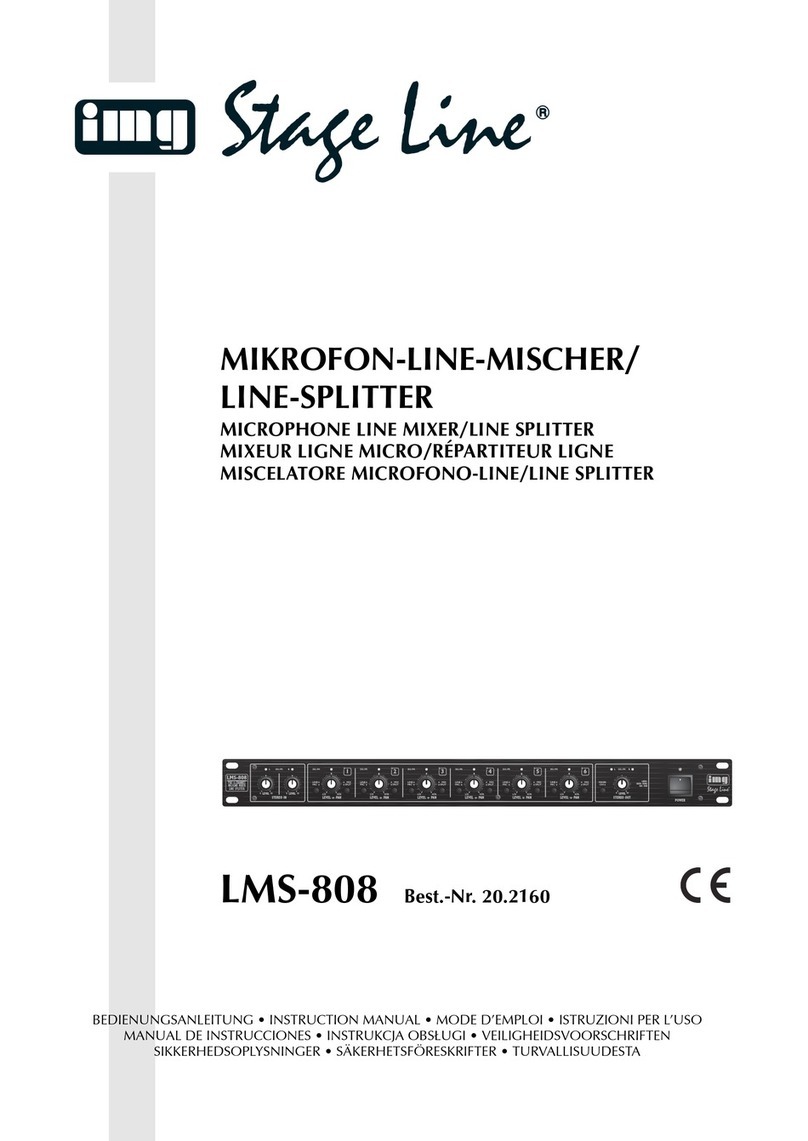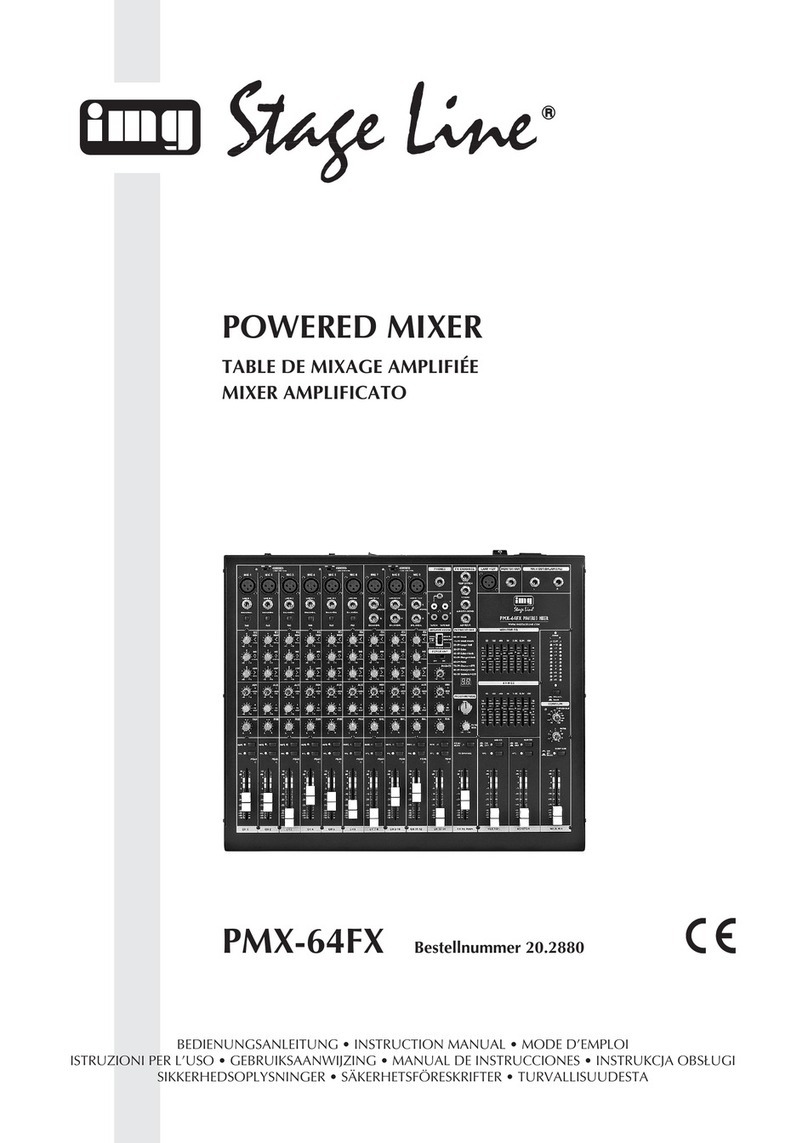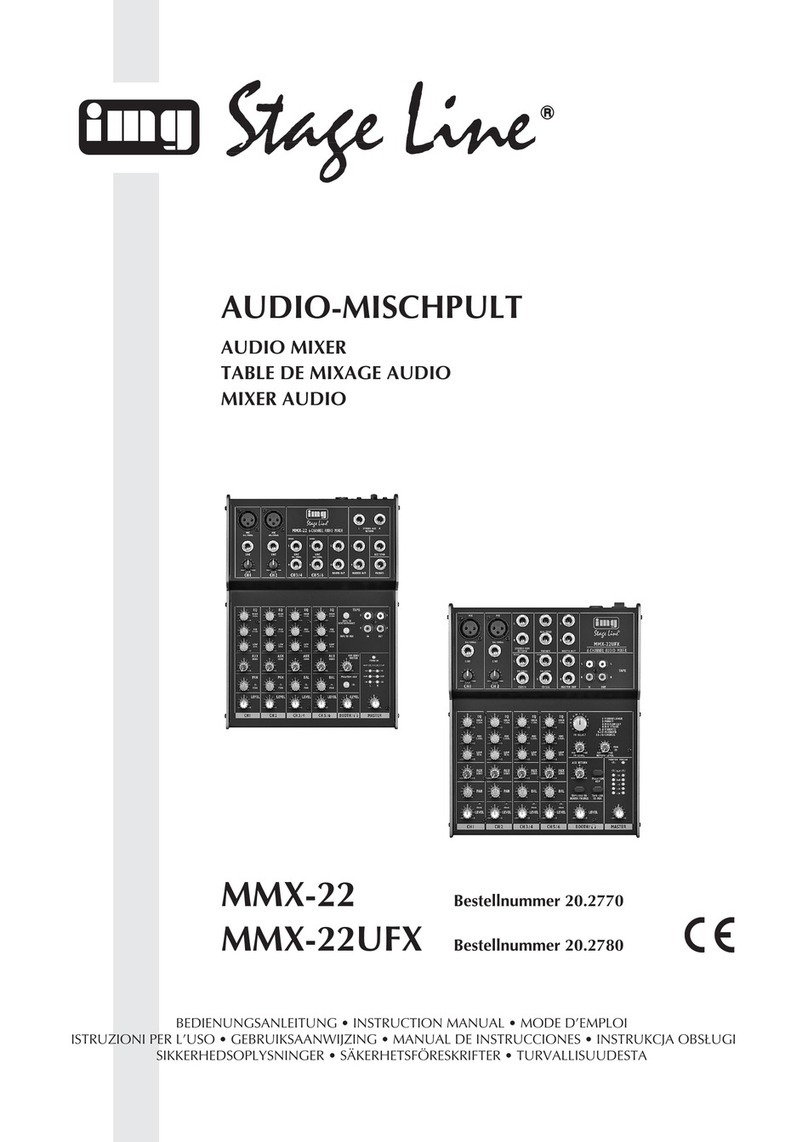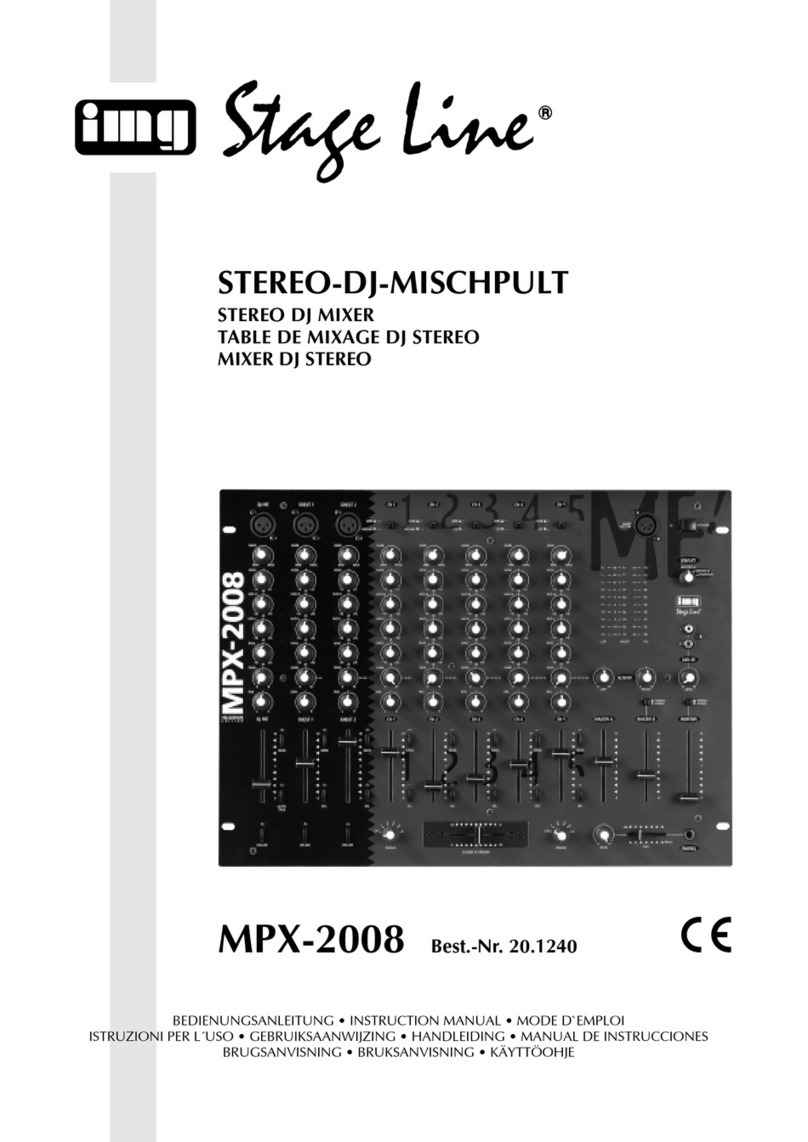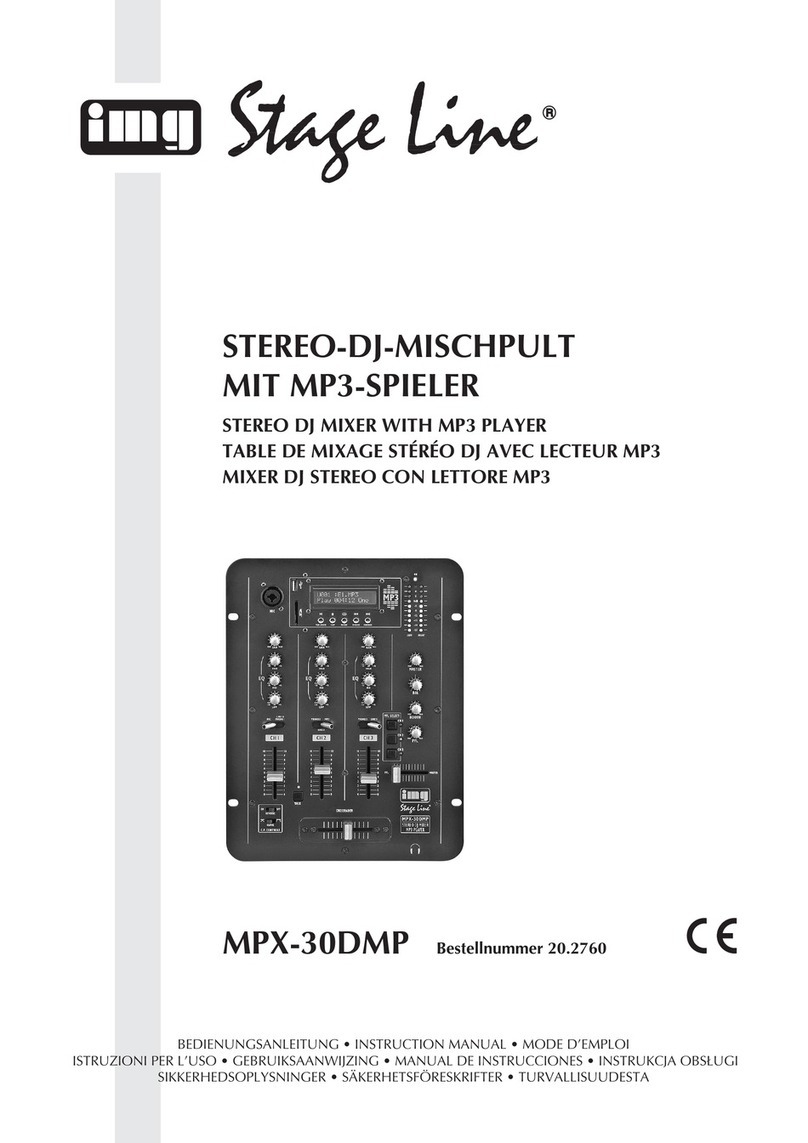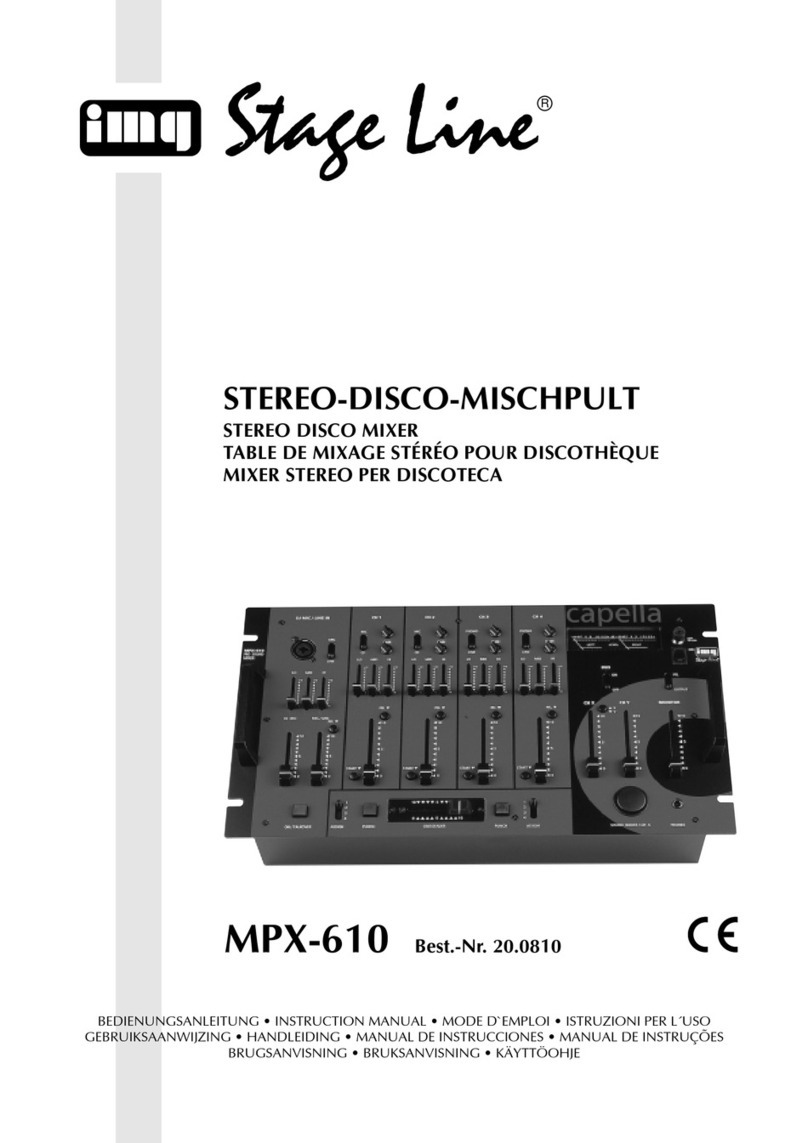1) Den Computer hochfahren und die USB-Buchse (4)
über das beiliegende USB-Kabel mit einem USB-
Anschluss am Computer verbinden. Die USB-
Schnittstelle des Mischpults wird vom Computer als
externes Gerät für die Toneingabe und Tonausgabe
erkannt, je nach Betriebssystem z. B. als „USB
Audio CODEC“. Die erforderlichen Treiber (Stan-
dard-Treiber des Betriebssystems) sind auf dem
Computer vorhanden.
Hinweis: Befinden sich nicht alle geforderten Treiber auf
dem Computer, müssen sie nachinstalliert werden, z. B.
über die Betriebssystem-Original-CD. Gegebenenfalls
nach der Installation den Computer neu starten.
2) Das verwendete Audio-Programm aufrufen und
dort die erforderlichen Einstellungen für die Tonwie-
dergabe über das Mischpult bzw. Tonaufnahme
vom Mischpult vornehmen (Anleitung des Pro-
gramms). Das Mischpult kann dann anhand Kapi-
tel 5 bedient werden.
Findet keine Tonaufnahme bzw. Tonwiedergabe statt,
in den Systemeinstellungen des Computers überprü-
fen, ob die USB-Schnittstelle für die Toneingabe bzw.
Tonausgabe angewählt ist.
Tipp: Ist das Mischpult sowohl mit einem Computer verbun-
den als auch mit Geräten, die über ihr Netzkabel geerdet sind
(z. B. Verstärker), können aufgrund von Masseschleifen
Brummstörungen auftreten. Um diese zu beseitigen, kann
das Mischpult über ein Massetrennfilter (z. B. FGA-102 oder
FGA-202 aus dem Programm von „img Stage Line“) mit dem
jeweiligen Gerät verbunden werden.
5 Bedienung
5.1 Tonquellen mischen
Die folgenden Bedienschritte dienen nur als Hilfestel-
lung, es sind auch andere Vorgehensweisen möglich.
1) Als Grundeinstellung vorerst
– alle Regler GAIN (16), EQ (17), PAN (19) und
BAL (20) sowie den Regler MASTER (29) in die
Mittelposition stellen
– alle Regler LEVEL (22) und den Effekt-Pegelreg-
ler FX (23) ganz nach links zurückdrehen
– die Taste ASSIGN TO MAIN (14) ausrasten
2) Soll das Eingangssignal der USB-Buchse (4) über
den Kanal CH 5/6 wiedergegeben werden, die Tas-
te USB ASSIGN TO CH 5/6 (13) drücken. Bei ge-
drückter Taste belegen das USB-Eingangssignal
und das Signal des Eingangs CH 5/6 (8) den glei-
chen Kanal. Deshalb den Eingang CH 5/6 nicht ver-
wenden, wenn nur das USB-Eingangssignal wie-
dergegeben werden soll, anderenfalls erhält der
Kanal das Mischsignal beider Quellen.
Hinweis: Beachten Sie bei Aufnahmen über die USB-
Buchse die Gefahr von Rückkopplungen, wenn das Auf-
nahmesignal des Computers als Eingangssignal auf den
Kanal CH 5/6 geschaltet wird.
3) Um einen Mono-Kanal optimal auszusteuern, ein
Tonsignal auf den Kanal geben und seinen Regler
LEVEL (22) bis ca. zur Mitte aufdrehen. Den Regler
GAIN (16) des Kanals so einstellen, dass bei den
lautesten Stellen die 0-dB-LEDs der Pegelanzeige
(28) kurz aufleuchten. Danach die Klangeinstellung
mit den Reglern EQ (17) durchführen: HI für die
Höhen, LO für die Bässe. Da sich Klangeinstellun-
gen auf den Kanalpegel auswirken, die Gain-Ein-
stellung ggf. korrigieren.
Danach den Regler LEVEL wieder ganz zurück-
drehen und die gleichen Einstellungen für den zwei-
ten Mono-Kanal durchführen.
4) Für die Klangeinstellung eines Stereo-Kanals die
Regler LEVEL (22) der übrigen Kanäle ganz zu-
rückdrehen und den Regler LEVEL des betreffen-
den Stereo-Kanals so weit aufdrehen, dass der
Klang mit den Klangreglern (17) optimal eingestellt
werden kann.
5) Sind alle Einstellungen zur Pegelanpassung und
alle Klangeinstellungen durchgeführt, mit den Reg-
lern LEVEL (22) die Signale der Eingangskanäle im
gewünschten Lautstärkeverhältnis mischen. Die
LEDs PK (21) der Mono-Kanäle sollten gar nicht
oder höchstens bei Signalspitzen kurz aufflackern.
Leuchten sie ständig, die Lautstärke des Kanals
reduzieren.
Die Regler LEVEL nicht benutzter Kanäle immer
ganz nach links zurückdrehen.
6) Für die Mono-Kanäle mit den Reglern PAN (19) die
Mono-Signale im Stereo-Klangbild platzieren und
für die Stereo-Kanäle mit den Reglern BAL (20) die
Stereo-Balance einstellen.
7) Um das Signal des Eingangs TAPE IN (9), z. B.
Bandeinspielungen oder CD-Wiedergabe, auf das
Summensignal zu schalten, die Taste ASSIGN TO
MAIN (14) drücken. Soll das TAPE-IN-Signal allein
auf die Summe gegeben werden, die Regler LEVEL
der Eingangskanäle ganz zurückdrehen.
Hinweis: Wird eine über den Ausgang TAPE OUT (10)
laufende Aufnahme zeitgleich über den Eingang TAPE IN
wiedergegeben, darf die Taste ASSIGN TO MAIN nicht
gedrückt sein, da sonst eine Rückkopplung auftritt.
8) Mit dem Regler MASTER (29) die gewünschte Ge-
samtlautstärke einstellen. Dabei die Pegelanzeige
(28) beachten. In der Regel wird bei 0 dB eine opti-
male Aussteuerung erreicht. Ist der Ausgangspegel
WARNUNG Stellen Sie die Lautstärke der Audio-
anlage und des Kopfhörers nie sehr
hoch ein. Hohe Lautstärken können auf
Dauer das Gehör schädigen! Das Ohr
gewöhnt sich an hohe Lautstärken und
empfindet sie nach einiger Zeit als nicht
mehr so hoch. Erhöhen Sie darum eine
hohe Lautstärke nach der Gewöhnung
nicht weiter.
6
CH
D
A

